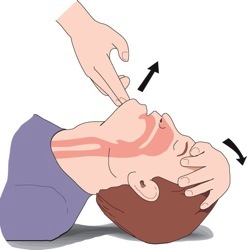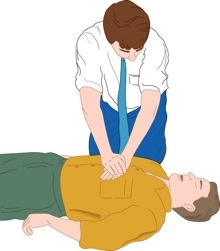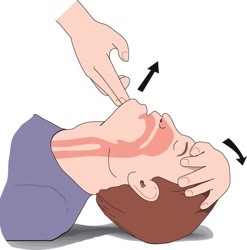|
Vitamin D Poll
Are you currently taking a Vitamin D supplement?
|
|
| | Emergency & First Aid: CPR: First Aid for Cardiopulmonary Resuscitation (CPR) - Emergency Conditions | |
American Institute for Preventive Medicine ©
CPR is cardiopulmonary resuscitation. Hands-Only CPR uses chest compressions without rescue breaths. Do this in 2 steps:
- Call 9-1-1 or get someone else to call!
- Push hard and push fast in the center of the chest. Give 100 compressions per minute. Keep this up, with minimal interruptions, until an automated external defibrillator (AED) is used or EMS arrives.
Any bystander can use this for adults only who suddenly collapse in places outside-the-hospital setting. Hands-Only CPR should not be used for:
- All infants and children.
- Adults who have collapsed due to near-drowning, a drug overdose, or breathing problems.
- Adults who are already unconscious and not breathing normally when found.
Conventional CPR For Adults and Children Over 8 Years Old
- Shout for help! Call or have someone else call 9-1-1 and get an AED, if one is nearby.
- Follow the 9-1-1 dispatcher's instructions.
- Until the AED can be used or until medical help arrives, do CPR.
- Open the airway. With one hand, tilt the person's head back. With 2 fingers of your other hand, lift the person's chin up. If the airway is still blocked, tilt the person's head gently and slowly until the airway is open.

- Within 10 seconds, check for breathing. Look to see if the chest and abdomen rise and fall. Listen for breath sounds exhaled from the person's mouth and nose. If the person is breathing, keep the airway open. Look for other problems.
- If you do not want to or can't give mouth-to-mouth rescue breaths, do compression-only-CPR. Go to step 7.

- Begin "Chest Compressions"
- Kneel at the person's side near the chest. Place the heel of one hand 1/2 inch above the "V" where the ribs join the breastbone. Place the other hand on top of the one already in place.

- Lean over the person and press straight down on the chest using only the heels of your hands. Keep your arms straight. Depress the middle of the chest between the nipples about 1-1/2 to 2 inches. Push hard and push fast! Give about 100 compressions a minute. Relax pressure completely after each compression.
- Give cycles of 30 chest compressions and 2 rescue breaths, without a break, until: The person moves; an AED is used; or medical help takes over.
CPR For Children Ages 1 to 8 Years Old
- Shout for help! If you are alone, do CPR first. (Do 5 cycles of 30 chest compressions and 2 breaths. See Steps 5 and 6 below.) Then call 9-1-1, get an AED, and return to the child. If the child is small and does not appear to have a serious injury, carry the child to a telephone and call 9-1-1! If you are not alone, one person should start CPR. Another person should Call 9-1-1 and get an AED.
- Put the child on his or her back.
- Open the child's airway, as for an adult. If the airway is still blocked, tilt the child's head gently and slowly until the airway is open.

- Within 10 seconds, check for breathing, as for an adult in Step 5 above. If the child is breathing, keep the airway open. Look for and give first aid for other problems, as needed. If the child appears to have no serious injury, put the child in the Recovery Position.
- If the child is not breathing, take a normal (not deep) breath and give 1 "Rescue Breath". Forming a tight seal, cover an infant's open mouth and nose with your mouth.

For a small child, pinch the nose closed, as for an adult. Give 1 full breath for 1 second. Give the 2nd full breath for 1 second. Each rescue breath should make the child's chest rise. If it doesn't, do head tilt and chin lift again.
- Begin "Chest Compressions"
- Lean over the child. Keeping your arms straight, press straight down on the chest using the heel(s) of 1 or both hands. Don't press on the child's ribs or the lowest part of the breastbone.
- Depress the middle of the chest between the nipples about 1/3 to 1/2 the depth of the chest.
- Push hard and push fast. Give about 100 compressions a minute. Relax pressure completely after each compression.
- Give cycles of 30 chest compressions and 2 rescue breaths, without a break. Do this 5 times. (This should take about 2 minutes.) Keep doing 30 chest compressions and 2 rescue breaths until the child starts to move, until an AED is used, or until medical help takes over. Always open the airway before giving rescue breaths.
{Note: Chest compressions alone are better than doing nothing, but it is best to do both rescue breathing and chest compressions in children. Why? Airway problems are the main cause of cardiac arrest in infants and children.}
For Babies Up to 1 Year Old
- Shout for help! If you are alone, do CPR first. Then call 9-1-1! If the child does not appear to have a serious injury, carry the child to a telephone and call 9-1-1. If you are not alone, one person should start CPR. Another person should Call 9-1-1!
- Use the tips of your middle and ring finger to compress the baby's chest. Slip the other hand under the baby's back for support. Depress the breastbone 1/2 to 1 inch at a rate of 100 times a minute.

CPR is cardiopulmonary resuscitation. Hands-Only CPR uses chest compressions without rescue breaths. Do this in 2 steps:
- Call 9-1-1 or get someone else to call!
- Push hard and push fast in the center of the chest. Give 100 compressions per minute. Keep this up, with minimal interruptions, until an automated external defibrillator (AED) is used or EMS arrives.
For more information, contact:
The American Heart Association
877.AHA.4CPR (242.4277)
American Red Cross
202.303.4498
(Excerpted from Healthy Self: The Guide to Self-Care and Wise Consumerism)
|
|
|
|